Seismic Soil Characterization to Estimate Site Effects Induced by Near-Fault Earthquakes: The Case Study of Pizzoli (Central Italy) during the Mw 6.7 2 February 1703, Earthquake
Abstract
1. Introduction
2. The Mw 6.2 7 February 1703, Earthquake
3. Geological Background of the Madonna delle Fornaci Site (Pizzoli, Central Italy)
4. Field Investigations
4.1. PB1 Borehole
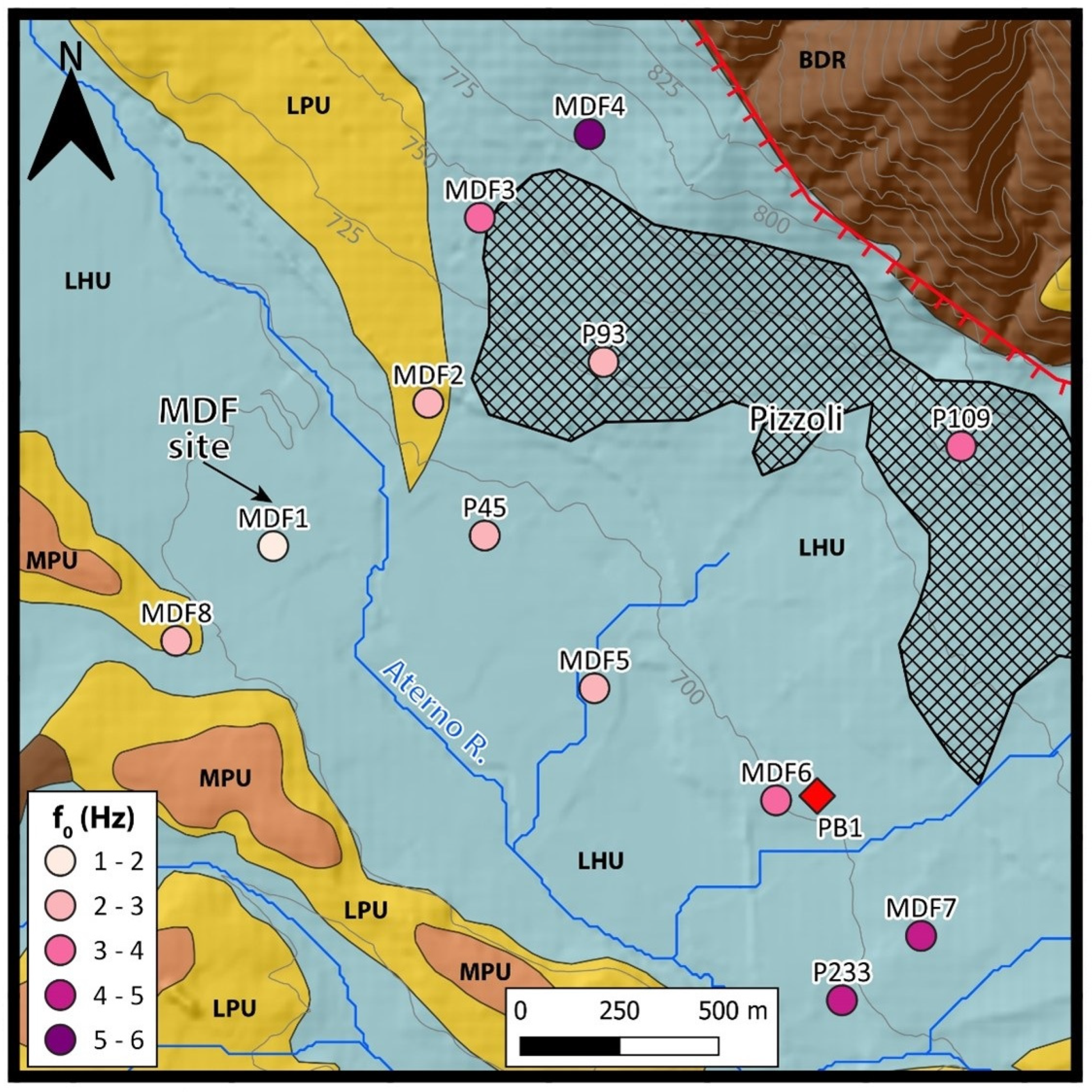
4.2. Microtremor Measurements
4.3. Site Investigation Program
- Phase 1 (July–August 2020)
- Phase 2 (November 2020–January 2021)
4.4. Site Characterization
4.4.1. Stratigraphy
4.4.2. Groundwater Table
4.4.3. Soil Property Interpretation from In Situ Tests
4.4.4. Interpretation of Geophysical Tests
5. Geotechnical Model
5.1. Seismic Bedrock Estimation
5.2. Dynamic Soil Properties at Large Strains
6. Ground Failure Interpretation
6.1. Simplified Liquefaction Analyses
6.2. Equivalent Linear Seismic Response Analyses
Input Motion Definition
6.3. Non-Linear Seismic Response Analyses
7. Discussion: The Earthquake-Induced Gas Eruption Hypothesis
8. Conclusions
Author Contributions
Funding
Data Availability Statement
Acknowledgments
Conflicts of Interest
References
- Galli, P. New empirical relationships between magnitude and distance for liquefaction. Tectonophysics 2000, 324, 169–187. [Google Scholar] [CrossRef]
- Gruppo di Lavoro, M.S. Indirizzi e criteri per la microzonazione sismica—Guidelines for seismic microzonation. Conferenza Delle Regioni e Delle Provincie Autonome; Dipartimento Della Protezione Civile: Rome, Italy, 2008; Volume 3, Available online: https://www.centromicrozonazionesismica.it/it/download/category/7-indirizzi-e-criteri-per-la-microzonazione-sismica (accessed on 6 December 2021).
- Guerrieri, L.; Blumetti, A.M.; Comerci, V.; Di Manna, P.; Michetti, A.M.; Vittori, E.; Serva, L. Surface Faulting Hazard in Italy: Towards a first assessment based on the ITHACA database. In Engineering Geology for Society and Territory; Springer: Berlin/Heidelberg, Germany, 2015; Volume 5, pp. 1021–1025. [Google Scholar]
- Storti, F.; Aldega, L.; Balsamo, F.; Corrado, S.; Del Monaco, F.; Di Paolo, L.; Mastalerz, M.; Monaco, P.; Tallini, M. Evidence for strong middle Pleistocene earthquakes in the epicentral area of the 6 April 2009 L’Aquila seismic event from sediment paleofluidization and overconsolidation. J. Geophys. Res. Solid Earth 2013, 118. [Google Scholar] [CrossRef]
- Civico, R.; Pucci, S.; Villani, F.; Pizzimenti, L.; De Martini, P.M.; Nappi, R.; Group, O.E.W. Surface ruptures following the 30 October 2016 M w 6.5 Norcia earthquake, central Italy. J. Maps 2018, 14, 151–160. [Google Scholar] [CrossRef]
- Berardi, R.; Margottini, C.; Molin, D.; Parisi, A. Soil liquefaction: Case histories in Italy. Tectonophysics 1991, 193, 141–164. [Google Scholar] [CrossRef]
- Boncio, P.; Amoroso, S.; Vessia, G.; Francescone, M.; Nardone, M.; Monaco, P.; Famiani, D.; Di Naccio, D.; Mercuri, A.; Manuel, M.R.; et al. Evaluation of liquefaction potential in an intermountain Quaternary lacustrine basin (Fucino basin, central Italy). Bull. Earthq. Eng. 2018, 16, 91–111. [Google Scholar] [CrossRef]
- Boncio, P.; Amoroso, S.; Galadini, F.; Galderisi, A.; Iezzi, G.; Liberi, F. Earthquake-induced liquefaction features in a late Quaternary fine-grained lacustrine succession (Fucino Lake, Italy): Implications for microzonation studies. Eng. Geol. 2020, 272, 105621. [Google Scholar] [CrossRef]
- Miranda, E.; Brzev, S.; Bijelic, N.; Arbanas, Ž.; Bartolac, M.; Jagodnik, V.; Lazarević, D.; Mihalić Arbanas, S.; Zlatović, S.; Acosta, A.; et al. Petrinja, Croatia December 29, 2020, Mw 6.4: Earthquake Joint Reconnaissance Report (JRR). PRJ-2959, Released: 22 January 2021. DesignSafe 2021, 206. [Google Scholar]
- Pollak, D.; Gulam, V.; Novosel, T.; Avanić, R.; Tomljenović, B.; Hećej, N.; Terzić, J.; Stipčević, J.; Bačić, M.; Kurečić, T. The preliminary inventory of coseismic ground failures related to December 2020–January 2021 Petrinja earthquake series. Geol. Croat. 2021, 74, 189–208. [Google Scholar] [CrossRef]
- Tondi, E.; Blumetti, A.M.; Čičak, M.; Di Manna, P.; Galli, P.; Invernizzi, C.; Mazzoli, S.; Piccardi, L.; Valentini, G.; Vittori, E. ‘Conjugate’coseismic surface faulting related with the 29 December 2020, Mw 6.4, Petrinja earthquake (Sisak-Moslavina, Croatia). Sci. Rep. 2021, 11, 1–15. [Google Scholar]
- Tomac, I.; Zlatović, S.; Zekkos, A.; Bleiziffer, J.; Domitrović, D.; Frangen, T.; Zelić, B.K.; Matoš, B.; Matešić, D.; Miha, I.; et al. Geotechnical Reconnaissance and Engineering Effects of the December 29, 2020, M6.4 Petrinja, Croatia Earthquake, and Associated Seismic Sequence; Report GEER-072, 2021. Available online: http://www.geerassociation.org/index.php/component/geer_reports/?view=geerreports&layout=build&id=99 (accessed on 20 December 2021).
- Ford, D.C.; Williams, P.W. Karst Geomorphology and Hydrology; Unwin Hyman: London, UK, 1989; Volume 601. [Google Scholar]
- Parise, M. Sinkholes. Encyclopedia of Caves; Elsevier: Amsterdam, The Netherlands, 2019; pp. 934–942. [Google Scholar]
- Rose, M.D.; Federico, A.; Parise, M. Sinkhole genesis and evolution in Apulia, and their interrelations with the anthropogenic environment. Nat. Hazards Earth Syst. Sci. 2004, 4, 747–755. [Google Scholar] [CrossRef]
- Gutiérrez, F.; Galve, J.P.; Guerrero, J.; Lucha, P.; Cendrero, A.; Remondo, J.; Bonachea, J.; Gutiérrez, M.; Sánchez, J.A. The origin, typology, spatial distribution and detrimental effects of the sinkholes developed in the alluvial evaporite karst of the Ebro River valley downstream of Zaragoza city (NE Spain). Earth Surf. Process. Landf. J. Br. Geomorphol. Res. Gr. 2007, 32, 912–928. [Google Scholar] [CrossRef]
- Jia, L.; Meng, Y.; Li, L.; Yin, R. A multidisciplinary approach in cover-collapse sinkhole analyses in the mantle karst from Guangzhou City (SE China). Nat. Hazards 2021, 108, 1389–1410. [Google Scholar] [CrossRef]
- Zumpano, V.; Pisano, L.; Parise, M. An integrated framework to identify and analyze karst sinkholes. Geomorphology 2019, 332, 213–225. [Google Scholar] [CrossRef]
- Del Prete, S.; Iovine, G.; Parise, M.; Santo, A. Origin and distribution of different types of sinkholes in the plain areas of Southern Italy. Geodin. Acta 2010, 23, 113–127. [Google Scholar] [CrossRef]
- Caramanna, G.; Ciotoli, G.; Nisio, S. A review of natural sinkhole phenomena in Italian plain areas. Nat. Hazards 2008, 45, 145–172. [Google Scholar] [CrossRef]
- Santo, A.; Ascione, A.; Del Prete, S.; Di Crescenzo, G.; Santangelo, N. Collapse sinkholes in the carbonate massifs of Central and Southern Apennines. Acta Carsologica 2011, 40. [Google Scholar] [CrossRef]
- Abelson, M.; Baer, G.; Shtivelman, V.; Wachs, D.; Raz, E.; Crouvi, O.; Kurzon, I.; Yechieli, Y. Collapse-sinkholes and radar interferometry reveal neotectonics concealed within the Dead Sea basin. Geophys. Res. Lett. 2003, 30. [Google Scholar] [CrossRef]
- Broughton, P.L. Breccia pipe and sinkhole linked fluidized beds and debris flows in the Athabasca Oil Sands: Dynamics of evaporite karst collapse-induced fault block collisions. Bull. Can. Pet. Geol. 2017, 65, 200–234. [Google Scholar] [CrossRef]
- Chiaro, G.; Kiyota, T.; Pokhrel, R.M.; Goda, K.; Katagiri, T.; Sharma, K. Reconnaissance report on geotechnical and structural damage caused by the 2015 Gorkha Earthquake, Nepal. Soils Found. 2015, 55, 1030–1043. [Google Scholar] [CrossRef]
- Comerci, V.; Vittori, E.; Blumetti, A.M.; Brustia, E.; Di Manna, P.; Guerrieri, L.; Lucarini, M.; Serva, L. Environmental effects of the December 28, 1908, Southern Calabria–Messina (Southern Italy) earthquake. Nat. Hazards 2015, 76, 1849–1891. [Google Scholar] [CrossRef]
- Lunina, O.; Andreev, A.; Gladkov, A. The 1950 M w = 6.9 Mondy earthquake in southern East Siberia and associated deformations: Facts and uncertainties. J. Seismol. 2015, 19, 171–189. [Google Scholar] [CrossRef]
- Santo, A.; Santangelo, N.; De Falco, M.; Forte, G.; Valente, E. Cover collapse sinkhole over a deep buried carbonate bedrock: The case study of Fossa San Vito (Sarno-Southern Italy). Geomorphology 2019, 345, 106838. [Google Scholar] [CrossRef]
- Anonymous. Relazione Distinta de’ Danni Cagionati da’ Passati Tremuoti nel Regno di Napoli e Nello Stato di Santa Chiesa in Quest’anno 1703; Napoli and Bologna. 1703. [Google Scholar]
- Antinori, A.L. Annali Degli Abruzzi Dalle Origini All’anno 1777; (edizione in facsimile); Arnaldo Forni Editore: Sala Bolognese, Italy, 1971; Volume 24. [Google Scholar]
- Baglivi, G.; Santorini, G.D.; Pellegrini, R. Opere Complete Medico-Pratiche ed Anatomiche; S. Coen: Florence, Italy, 1842. [Google Scholar]
- Quinzi, A.; Cherubini, G.F.; Ciampella, C.; Galle, S. Relazione su L’essere Della Città dell’Aquila, e Delle Cose più Notabili Succedute Nella Medema, e Nelli Luoghi Della sua Pro-Vincia per li Terremoti Occorsi nel Mese di Gennaro e di Febbraro 1703 Anno Corrente [Con Emendazioni di C.Garofalo], in V.Zannet. “Bollettino della Società di Storia Patria Anton Ludovico Antinori negli Abruzzi”. L’Aquila. Available online: http://storing.ingv.it/cfti/cfti4/quakes/01285.html#bibliography (accessed on 20 December 2021).
- Uria De Llanos, A. Relazione, Overo Itinerario Fatto Dall’auditore D.Alfonso Uria De Llanos per Riconoscere li Danni Causati Dalli Passati Terre-moti Seguiti li 14 Gennaro, e 2 Febraro MDCCIII con il Numero de’ Morti, e Feriti Nella Provincia dell’Aquila, e Tutti li Luoghi; Stamperia Gaetano Zenobi, Roma, 1703. Available online: https://gallica.bnf.fr/ark:/12148/bpt6k3100317/f1.item (accessed on 20 December 2021).
- Blumetti, A.M. Neotectonic investigations and evidence of paleoseismicity in the epicentral area of the January–February 1703, Central Italy, earthquakes. Perspect. Paleoseismol. 1995, 6, 83–100. [Google Scholar]
- Galadini, F. I terremoti in Abruzzo e la cultura sismologica tra la fine dell’Ottocento ei primi del Novecento. In Pareva Quel Giorno dell’Universal Giuditio; Edizioni Kirke: Avezzano, Italy, 2013; 256p. [Google Scholar]
- Galli, P.A.C.; Giaccio, B.; Messina, P.; Peronace, E.; Zuppi, G.M. Palaeoseismology of the L’Aquila faults (central Italy, 2009, Mw6.3 earthquake): Implications for active fault linkage. Geophys. J. Int. 2011, 187, 1119–1134. [Google Scholar] [CrossRef]
- Galli, P.; Giaccio, B.; Messina, P. The 2009 central Italy earthquake seen through 0.5 Myr-long tectonic history of the L’Aquila faults system. Quat. Sci. Rev. 2010, 29, 3768–3789. [Google Scholar] [CrossRef]
- Moro, M.; Bosi, V.; Galadini, F.; Galli, P.; Giaccio, B.; Messina, P.; Sposato, A. Analisi paleosismologiche lungo la faglia del M. Marine (alta valle dell’Aterno): Risultati preliminari. Quaternario 2002, 15, 267–278. [Google Scholar]
- Cello, G.; Mazzoli, S.; Tondi, E. The crustal fault structure responsible for the 1703 earthquake sequence of central Italy. J. Geodyn. 1998, 26, 443–460. [Google Scholar] [CrossRef]
- Galli, P.; Galadini, F.; Pantosti, D. Twenty years of paleoseismology in Italy. Earth-Sci. Rev. 2008, 88, 89–117. [Google Scholar] [CrossRef]
- Rovida, A.; Mario, L.; Romano, C.; Lolli, B.; Gasperini, P. The Italian earthquake catalogue CPTI15. Bull. Earthq. Eng. 2020, 18, 2953–2984. [Google Scholar] [CrossRef]
- Rovida, A.; Locati, M.; Camassi, R.; Lolli, B.; Gasperini, P.; Antonucci, A. The Italian Earthquake Catalogue CPTI15—Version 3.0; Istituto Nazionale di Geofisica e Vulcanologia: Rome, Italy, 2021. [Google Scholar]
- Galadini, F.; Galli, P. Active tectonics in the central Apennines (Italy)–input data for seismic hazard assessment. Nat. Hazards 2000, 22, 225–268. [Google Scholar] [CrossRef]
- Giraudi, C. Middle to Late Holocene glacial variations, periglacial processes and alluvial sedimentation on the higher Apennine massifs (Italy). Quat. Res. 2005, 64, 176–184. [Google Scholar] [CrossRef]
- Meletti, C.; Montaldo, V. Stime di Pericolosità Sismica per Diverse Probabilità di Superamento in 50 anni: Valori di ag. Progetto INGV-DPC S1, Deliverable D2; Istituto Nazionale di Geofisica e Vulcanologia: Rome, Italy, 2007. [Google Scholar]
- Guidoboni, E.; Ferrari, G.; Mariotti, D.; Comastri, A.; Tarabusi, G.; Sgattoni, G.; Valensise, G. CFTI5Med, Catalogo dei Forti Terremoti in Italia (461 aC-1997) e nell’Area Mediterranea (760 aC–1500); Istituto Nazionaledi Geofisicae Vulcanologia: Rome, Italy, 2018. [Google Scholar]
- Cinti, F.R.; Civico, R.; Blumetti, A.M.; Chiarini, E.; La Posta, E.; Pantosti, D.; Papasodaro, F.; Smedile, A.; De Martini, P.M.; Villani, F. Evidence for surface faulting earthquakes on the Montereale fault system (Abruzzi Apennines, central Italy). Tectonics 2018, 37, 2758–2776. [Google Scholar] [CrossRef]
- Patacca, E.; Sartori, R.; Scandone, P. Tyrrhenian basin and Apenninic arcs: Kinematic relations since late Tortonian times. Mem. della Soc. Geol. Ital. 1990, 45, 425–451. [Google Scholar]
- Royden, L.H. Evolution of retreating subduction boundaries formed during continental collision. Tectonics 1993, 12, 629–638. [Google Scholar] [CrossRef]
- Cosentino, D.; Cipollari, P.; Marsili, P.; Scrocca, D. Geology of the central Apennines: A regional review. J. Virtual Explor. 2010, 36. [Google Scholar] [CrossRef]
- Pierantoni, P.P.; Chicco, J.; Costa, M.; Invernizzi, C. Plio-Quaternary transpressive tectonics: A key factor in the structural evolution of the outer Apennine–Adriatic system, Italy. J. Geol. Soc. 2019, 176, 1273–1283. [Google Scholar] [CrossRef]
- Vezzani, L.; Ghisetti, F.; Bigozzi, A.; Follador, U.; Casnedi, R. Carta Geologica dell’Abruzzo: Scala 1: 100,000; SELCA: Florence, Italy, 1998. [Google Scholar]
- Cosentino, D.; Asti, R.; Nocentini, M.; Gliozzi, E.; Kotsakis, T.; Mattei, M.; Esu, D.; Spadi, M.; Tallini, M.; Cifelli, F. New insights into the onset and evolution of the central Apennine extensional intermontane basins based on the tectonically active L’Aquila Basin (central Italy). Bulletin 2017, 129, 1314–1336. [Google Scholar] [CrossRef]
- Cavinato, G.P.; Carusi, C.; Dall’Asta, M.; Miccadei, E.; Piacentini, T. Sedimentary and tectonic evolution of Plio-Pleistocene alluvial and lacustrine deposits of Fucino Basin (central Italy). Sediment. Geol. 2002, 148, 29–59. [Google Scholar] [CrossRef]
- Tallini, M.; Spadi, M.; Cosentino, D.; Nocentini, M.; Cavuoto, G.; Di Fiore, V. High-resolution seismic reflection exploration for evaluating the seismic hazard in a Plio-Quaternary intermontane basin (L’Aquila downtown, central Italy). Quat. Int. 2019, 532, 34–47. [Google Scholar] [CrossRef]
- Antonielli, B.; Della Seta, M.; Esposito, C.; Mugnozza, G.S.; Schilirò, L.; Spadi, M.; Tallini, M. Quaternary rock avalanches in the Apennines: New data and interpretation of the huge clastic deposit of the L’Aquila Basin (central Italy). Geomorphology 2020, 361, 107194. [Google Scholar] [CrossRef]
- Messina, P.; Bosi, C.; Moro, M. Sedimenti e forme quaternari nell’alta valle dell’Aterno (L’Aquila). Quaternario 2003, 16, 231–239. [Google Scholar]
- Tallini, M.; Cavuoto, G.; Del Monaco, F.; Di Fiore, V.; Mancini, M.; Caielli, G.; Cavinato, G.P.; De Franco, R.; Pelosi, N.; Rapolla, A. Seismic surveys integrated with geological data for in-depth investigation of Mt. Pettino active Fault area (Western L’Aquila Basin). Ital. J. Geosci. 2012, 131, 389–402. [Google Scholar] [CrossRef]
- Messina, P.; Moro, M.; Speranza, F. Primi risultati di stratigrafia magnetica su alcune formazioni continentali dell’alta valle dell’Aterno (Italia centrale). Quaternario 2001, 14, 167–172. [Google Scholar]
- Bosi, C.; Galadini, F.; Giaccio, B.; Messina, P.; Sposato, A. Plio-Quaternary continental deposits in the Latium-Abruzzi Apennines: The correlation of geological events across different intermontane basins. Quaternario 2003, 16, 55–76. [Google Scholar]
- Conte, G.; Martarelli, L.; Monti, G.M.; Motteran, G.; Scalise, A.R.; Serafini, R.; Silvi, A. Caratteristiche idrogeologiche del foglio n. 348 “Antrodoco della carta Geologica d’Italia alla scala 1: 50.000 “Hydrogeological features of the sheet n. 348 ‘Antrodoco’ area, Geological Map of Italy, 1: 50.000 scale. Mem. Descr. Cart. Geol. d’It 2018, 103, 7–60. [Google Scholar]
- Berti, D.; Blumetti, A.; Capotorti, F.; Chiarini, E.; D’Ambrogi, C.; Di Stefano, R.; Fiorentino, A.; Guerrieri, L.; La Posta, E.; Marino, M. La geologia del Foglio n. 348 Antrodoco. Mem. Descr. Cart. Geol. d’Italia 2009, 88, 134. [Google Scholar]
- Nakamura, Y. A method for dynamic characteristics estimation of subsurface using microtremor on the ground surface. Railw. Tech. Res. Inst. Q. Rep. 1989, 30, 25–33. [Google Scholar]
- Del Monaco, F.; Tallini, M.; De Rose, C.; Durante, F. HVNSR survey in historical downtown L’Aquila (central Italy): Site resonance properties vs. subsoil model. Eng. Geol. 2013, 158, 34–47. [Google Scholar] [CrossRef]
- Di Giulio, G.; Ercoli, M.; Vassallo, M.; Porreca, M. Investigation of the Norcia basin (Central Italy) through ambient vibration measurements and geological surveys. Eng. Geol. 2020, 267, 105501. [Google Scholar] [CrossRef]
- Durante, F.; Di Giulio, G.; Tallini, M.; Milana, G.; Macerola, L. A multidisciplinary approach to the seismic characterization of a mountain top (Monteluco, central Italy). Phys. Chem. Earth 2017, 98, 119–135. [Google Scholar] [CrossRef]
- Macerola, L.; Tallini, M.; Di Giulio, G.; Nocentini, M.; Milana, G. The 1-D and 2-D Seismic Modeling of Deep Quaternary Basin (Downtown L’Aquila, Central Italy). Earthq. Spectra 2019, 35, 1689–1710. [Google Scholar] [CrossRef]
- Gosar, A.; Lenart, A. Mapping the thickness of sediments in the Ljubljana Moor basin (Slovenia) using microtremors. Bull. Earthq. Eng. 2010, 8, 501–518. [Google Scholar] [CrossRef]
- Lanzo, G.; Tallini, M.; Milana, G.; Di Capua, G.; Del Monaco, F.; Pagliaroli, A.; Peppoloni, S. The Aterno valley strong-motion array: Seismic characterization and determination of subsoil model. Bull. Earthq. Eng. 2011, 9, 1855–1875. [Google Scholar] [CrossRef]
- Saroli, M.; Albano, M.; Modoni, G.; Moro, M.; Milana, G.; Spacagna, R.-L.; Falcucci, E.; Gori, S.; Mugnozza, G.S. Insights into bedrock paleomorphology and linear dynamic soil properties of the Cassino intermontane basin (Central Italy). Eng. Geol. 2020, 264, 105333. [Google Scholar] [CrossRef]
- Tallini, M.; Lo Sardo, L.; Spadi, M. Seismic site characterisation of Red Soil and soil-building resonance effects in L’Aquila downtown (Central Italy). Bull. Int. Assoc. Eng. Geol. 2020, 79, 4021–4034. [Google Scholar] [CrossRef]
- Spadi, M.; Tallini, M.; Albano, M.; Cosentino, D.; Nocentini, M.; Saroli, M. New insights on bedrock morphology and local seismic amplification of the Castelnuovo village (L’Aquila Basin, central Italy). In press.
- Acerra, C.; Havenith, H.B.; Zacharopoulos, S. SESAME Guidelines for the Implementation of the H/V Spectral Ratio Technique on Ambient Vibrations-Measurements, Processing and Interpretations; European Commission: Brussels, Belgium, 2004. [Google Scholar]
- Wathelet, M.; Chatelain, J.; Cornou, C.; Di Giulio, G.; Guillier, B.; Ohrnberger, M.; Savvaidis, A. Geopsy: A user-friendly open-source tool set for ambient vibration processing. Seismol. Res. Lett. 2020, 91, 1878–1889. [Google Scholar] [CrossRef]
- Konno, K.; Ohmachi, T. Ground-motion characteristics estimated from spectral ratio between horizontal and vertical components of microtremor. Bull. Seismol. Soc. Am. 1998, 88, 228–241. [Google Scholar] [CrossRef]
- Tatoni, S.; D’Onofrio, K.; Presciutti, A. Microzonazione Sismica di Livello 3—Comune di Pizzoli (AQ) Relazione Illustrativa; Comune di Pizzoli (L’Aquila), Italy, 2018. Available online: https://www.comune.pizzoli.aq.it/c066072/zf/index.php/servizi-aggiuntivi/index/index/idtesto/57 (accessed on 20 December 2021).
- Albarello, D.; Castellaro, S. Tecniche sismiche passive: Indagini a stazione singola. Ing. Sismica 2011, 38, 32–49. [Google Scholar]
- Martelli, L. Assessment of Seismic Bedrock in Deep Alluvial Plains. Case Studies from the Emilia-Romagna Plain. Geosciences 2021, 11, 297. [Google Scholar] [CrossRef]
- Cubrinovski, M.; Ishihara, K. Empirical correlation between SPT N-value and relative density for sandy soils. Soils Found. 1999, 39, 61–71. [Google Scholar] [CrossRef]
- Bolton, M.D. The strength and dilatancy of sands. Geotechnique 1986, 36, 65–78. [Google Scholar] [CrossRef]
- NTC, D.M. 17.01.2018 Aggiornamento delle Norme Tecniche per le Costruzioni—Italian Building Code, Rome, 2018. Available online: chrome-extension://efaidnbmnnnibpcajpcglclefindmkaj/viewer.html?pdfurl=https%3A%2F%2Fwww.gazzettaufficiale.it%2Feli%2Fgu%2F2018%2F02%2F20%2F42%2Fso%2F8%2Fsg%2Fpdf&clen=9888288 (accessed on 20 December 2021).
- Foti, S.; Hollender, F.; Garofalo, F.; Albarello, D.; Asten, M.; Bard, P.Y.; Comina, C.; Cornou, C.; Cox, B.; Di Giulio, G.; et al. Guidelines for the Good Practice of Surface Wave Analysis: A Product of the InterPACIFIC Project. Bull. Earthq. Eng. 2018, 16, 2367–2420. [Google Scholar] [CrossRef]
- Ibs-von Seht, M.; Wohlenberg, J. Microtremor measurements used to map thickness of soft sediments. Bull. Seismol. Soc. Am. 1999, 89, 250–259. [Google Scholar] [CrossRef]
- D’Amico, V.; Picozzi, M.; Baliva, F.; Albarello, D. Ambient noise measurements for preliminary site-effects characterization in the urban area of Florence, Italy. Bull. Seismol. Soc. Am. 2008, 98, 1373–1388. [Google Scholar] [CrossRef]
- Parolai, S.; Picozzi, M.; Richwalski, S.M.; Milkereit, C. Joint inversion of phase velocity dispersion and H/V ratio curves from seismic noise recordings using a genetic algorithm, considering higher modes. Geophys. Res. Lett. 2005, 32. [Google Scholar] [CrossRef]
- Picozzi, M.; Parolai, S.; Albarello, D. Statistical analysis of noise horizontal-to-vertical spectral ratios (HVSR). Bull. Seismol. Soc. Am. 2005, 95, 1779–1786. [Google Scholar] [CrossRef]
- Picozzi, M.; Albarello, D. Combining genetic and linearized algorithms for a two-step joint inversion of Rayleigh wave dispersion and H/V spectral ratio curves. Geophys. J. Int. 2007, 169, 189–200. [Google Scholar] [CrossRef]
- Albarello, D.; Cesi, C.; Eulilli, V.; Guerrini, F.; Lunedei, E.; Paolucci, E.; Pileggi, D.; Puzzilli, L.M. The contribution of the ambient vibration prospecting in seismic microzoning: An example from the area damaged by the April 6, 2009 L’Aquila (Italy) earthquake. Boll. Geof. Teor. Appl. 2011, 52, 513–538. [Google Scholar]
- Foti, S.; Parolai, S.; Albarello, D.; Picozzi, M. Application of surface-wave methods for seismic site characterization. Surv. Geophys. 2011, 32, 777–825. [Google Scholar] [CrossRef]
- Kottke, A.R.; Wang, X.; Rathje, E.M. Strata Technical Manual. 2018. Available online: https://github.com/arkottke/strata/blob/master/manual/manual.pdf (accessed on 6 December 2021).
- Cococcia, S. Analisi della risposta sismica locale e dei fenomeni di liquefazione indotti dal sisma del 6 aprile 2009 nel sito di Ponte Rasarolo (L’Aquila). Master’s Thesis, University of L’Aquila, L’Aquila, Italy, 2017. [Google Scholar]
- Darendeli, D.M. Development of a New Family of Normalized Modulus Reduction and Material Damping Curves; The University of Texas at Austin: Austin, TX, USA, 2001. [Google Scholar]
- Kokusho, T.; Esashi, Y. Cyclic triaxial test on sands and coarse materials. In Proceedings of the 10th International Conference on Soil Mechanics and Foundation Engineering, Stockholm, Sweden, 15–19 June 1981; 1981; Volume 1, pp. 673–679. [Google Scholar]
- Rollins, K.M.; Evans, M.D.; Diehl, N.B.; Daily, W.D., III. Shear modulus and damping relationships for gravels. J. Geotech. Geoenvironmental Eng. 1998, 124, 396–405. [Google Scholar] [CrossRef]
- Menq, F.-Y. Dynamic Properties of Sandy and Gravelly Soils; The Univeristy of Texas at Austin: Austin, TX, USA, 2003; Volume 310. [Google Scholar]
- Modoni, G.; Gazzellone, A. Simplified theoretical analysis of the seismic response of artificially compacted gravels. In Proceedings of the International Conferences on Recent Advances in Geotechnical Earthquake Engineering and Soil Dynamics, San Diego, CA, USA, 24–29 May 2010. [Google Scholar]
- Rollins, K.M.; Singh, M.; Roy, J. Simplified Equations for Shear-Modulus Degradation and Damping of Gravels. J. Geotech. Geoenvironmental Eng. 2020, 146, 04020076. [Google Scholar] [CrossRef]
- Chiaradonna, A.; Tropeano, G.; D’Onofrio, A.; Silvestri, F. Development of a simplified model for pore water pressure build-up induced by cyclic loading. Bull. Earthq. Eng. 2018. [Google Scholar] [CrossRef]
- Tropeano, G.; Chiaradonna, A.; d’Onofrio, A.; Silvestri, F. An innovative computer code for 1D seismic response analysis including shear strength of soils. Geotechnique 2016, 66, 95–105. [Google Scholar] [CrossRef]
- Chiaradonna, A.; Tropeano, G.; d’Onofrio, A.; Silvestri, F. A Simplified Method for Pore Pressure Buildup Prediction: From Laboratory Cyclic Tests to the 1D Soil Response Analysis in Effective Stress Conditions. Procedia Eng. 2016, 158, 302–307. [Google Scholar] [CrossRef]
- Tropeano, G.; Chiaradonna, A.; d’Onofrio, A.; Silvestri, F. A numerical model for non-linear coupled analysis of the seismic response of liquefiable soils. Comput. Geotech. 2019, 105. [Google Scholar] [CrossRef]
- Chiaradonna, A.; D’onofrio, A.; Silvestri, F.; Tropeano, G. Prediction of non-linear soil behaviour in saturated sand: A loosely coupled approach for 1d effective stress analysis. In Earthquake Geotechnical Engineering for Protection and Development of Environment and Constructions; CRC Press/Balkema: Leiden, The Netherlands, 2019; pp. 1746–1753. [Google Scholar]
- Chiaradonna, A.; Flora, A.; d’Onofrio, A.; Bilotta, E. A pore water pressure model calibration based on in-situ test results. Soils Found. 2020, 60, 327–341. [Google Scholar] [CrossRef]
- Boulanger, R.W.; Idriss, I.M. CPT and SPT based liquefaction triggering procedures. Cent. Geotech. Model. Report N. UCD/ CGM-14/01. 2014, 134. [Google Scholar]
- Andrus, R.D.; Stokoe, K.H., II. Liquefaction resistance of soils from shear-wave velocity. J. Geotech. Geoenvironmental Eng. 2000, 126, 1015–1025. [Google Scholar] [CrossRef]
- Kayen, R.; Moss, R.E.S.; Thompson, E.M.; Seed, R.B.; Cetin, K.O.; Der Kiureghian, A.; Tanaka, Y.; Tokimatsu, K. Shear-wave velocity–based probabilistic and deterministic assessment of seismic soil liquefaction potential. J. Geotech. Geoenvironmental Eng. 2013, 139, 407–419. [Google Scholar] [CrossRef]
- Gomez-Capera, A.A.; D’Amico, M.; Lanzano, G.; Locati, M.; Santulin, M. Relationships between ground motion parameters and macroseismic intensity for Italy. Bull. Earthq. Eng. 2020, 18, 5143–5164. [Google Scholar] [CrossRef]
- Luzi, L.; Pacor, F.; Puglia, R. Italian Accelerometric Archive v 2.3. Istituto Nazionale di Geofisica e Vulcanologia. Dipartimento Protezione Civile Nazionale. 2017. Available online: http://itaca.mi.ingv.it/ItacaNet_31/#/home (accessed on 6 December 2021).
- JRC European Commission. Eurocode 8: Seismic Design of Buildings Worked Examples; JRC European Commission: Bruxelles, Belgium, 2004; Volume 1. [Google Scholar]
- Masi, A.; Chiauzzi, L.; Nicodemo, G.; Manfredi, V. Correlations between macroseismic intensity estimations and ground motion measures of seismic events. Bull. Earthq. Eng. 2020, 18, 1899–1932. [Google Scholar] [CrossRef]
- Ishihara, K.; Perlea, V. Liquefaction-Associated Ground Damage During the Vrancea Earthquake of March 4, 1977. Soils Found. 1984, 24, 90–112. [Google Scholar] [CrossRef][Green Version]
- Régnier, J.; Bonilla, L.F.; Bard, P.Y.; Bertrand, E.; Hollender, F.; Kawase, H.; Sicilia, D.; Arduino, P.; Amorosi, A.; Asimaki, D.; et al. International benchmark on numerical simulations for 1D, nonlinear site response (Prenolin): Verification phase based on canonical cases. Bull. Seismol. Soc. Am. 2016, 106, 2112–2135. [Google Scholar] [CrossRef]
- Régnier, J.; Bonilla, L.; Bard, P.; Bertrand, E.; Hollender, F.; Kawase, H.; Sicilia, D.; Arduino, P.; Amorosi, A.; Asimaki, D.; et al. PRENOLIN: International Benchmark on 1D Nonlinear Site-Response Analysis—Validation Phase Exercise. Bull. Seismol. Soc. Am. 2018. [Google Scholar] [CrossRef]
- Chiaradonna, A.; Lirer, S.; Flora, A. A liquefaction potential integral index based on pore pressure build-up. Eng. Geol. 2020, 272, 105620. [Google Scholar] [CrossRef]
- Chiodini, G.; Cardellini, C.; Amato, A.; Bosch, E.; Caliro, S.; Frondini, F.; Ventura, G. Carbon dioxide Earth degassing and seismogenesis in central and southern Italy. Geophys. Res. Lett. 2004, 31. [Google Scholar] [CrossRef]
- Miller, S.A.; Collettini, C.; Chiaraluce, L.; Cocco, M.; Barchi, M.; Kaus, B.J.P. Aftershocks driven by a high-pressure CO 2 source at depth. Nature 2004, 427, 724–727. [Google Scholar] [CrossRef] [PubMed]
- Chiodini, G.; Caliro, S.; Cardellini, C.; Frondini, F.; Inguaggiato, S.; Matteucci, F. Geochemical evidence for and characterization of CO2 rich gas sources in the epicentral area of the Abruzzo 2009 earthquakes. Earth Planet. Sci. Lett. 2011, 304, 389–398. [Google Scholar] [CrossRef]
- Giordano, G.; Carapezza, M.L.; Della Monica, G.; Todesco, M.; Tuccimei, P.; Carlucci, G.; De Benedetti, A.A.; Gattuso, A.; Lucchetti, C.; Piersanti, M. Conditions for long-lasting gas eruptions: The 2013 event at Fiumicino International Airport (Rome, Italy). J. Volcanol. Geotherm. Res. 2016, 325, 119–134. [Google Scholar] [CrossRef]
- Doglioni, C.; Barba, S.; Carminati, E.; Riguzzi, F. Fault on–off versus coseismic fluids reaction. Geosci. Front. 2014, 5, 767–780. [Google Scholar] [CrossRef]
- Boschetti, T.; Barbieri, M.; Barberio, M.D.; Billi, A.; Franchini, S.; Petitta, M. CO2 inflow and elements desorption prior to a seismic sequence, Amatrice-Norcia 2016, Italy. Geochem. Geophys. Geosyst. 2019, 20, 2303–2317. [Google Scholar]
- De Luca, G.; Di Carlo, G.; Tallini, M. Hydraulic pressure variations of groundwater in the Gran Sasso underground laboratory during Amatrice earthquake of August 24th, 2016. Ann. Geophys. 2016, 59. [Google Scholar] [CrossRef]
- De Luca, G.; Di Carlo, G.; Tallini, M. A record of changes in the Gran Sasso groundwater before, during and after the 2016 Amatrice earthquake, central Italy. Sci. Rep. 2018, 8, 1–16. [Google Scholar] [CrossRef] [PubMed]
- Petitta, M.; Mastrorillo, L.; Preziosi, E.; Banzato, F.; Barberio, M.D.; Billi, A.; Cambi, C.; De Luca, G.; Di Carlo, G.; Di Curzio, D. Water-table and discharge changes associated with the 2016–2017 seismic sequence in central Italy: Hydrogeological data and a conceptual model for fractured carbonate aquifers. Hydrogeol. J. 2018, 26, 1009–1026. [Google Scholar] [CrossRef]
- Chiarabba, C.; Buttinelli, M.; Cattaneo, M.; De Gori, P. Large earthquakes driven by fluid overpressure: The Apennines normal faulting system case. Tectonics 2020, 39, e2019TC006014. [Google Scholar] [CrossRef]
- Pio Lucente, F.; De Gori, P.; Margheriti, L.; Piccinini, D.; Di Bona, M.; Chiarabba, C.; Piana Agostinetti, N. Temporal variation of seismic velocity and anisotropy before the 2009 MW 6.3 L’Aquila earthquake, Italy. Geology 2010, 38, 1015–1018. [Google Scholar] [CrossRef]
- Terakawa, T.; Zoporowski, A.; Galvan, B.; Miller, S.A. High-pressure fluid at hypocentral depths in the L’Aquila region inferred from earthquake focal mechanisms. Geology 2010, 38, 995–998. [Google Scholar] [CrossRef]
- Freeze, R.A.; Cherry, J. Groundwater; Prenctice Hall. Inc.: Hoboken, NJ, USA, 1979. [Google Scholar]
- Ciotoli, G.; Bigi, S.; Tartarello, C.; Sacco, P.; Lombardi, S.; Ascione, A.; Mazzoli, S. Soil gas distribution in the main coseismic surface rupture zone of the 1980, Ms = 6.9, Irpinia earthquake (southern Italy). J. Geophys. Res. Solid Earth 2014, 119, 2440–2461. [Google Scholar] [CrossRef]
- Rosen, M.R.; Binda, G.; Archer, C.; Pozzi, A.; Michetti, A.M.; Noble, P.J. Mechanisms of earthquake-induced chemical and fluid transport to carbonate groundwater springs after earthquakes. Water Resour. Res. 2018, 54, 5225–5244. [Google Scholar] [CrossRef]
- Roberts, J.J.; Wilkinson, M.; Naylor, M.; Shipton, Z.K.; Wood, R.A.; Haszeldine, R.S. Natural CO2 sites in Italy show the importance of overburden geopressure, fractures and faults for CO2 storage performance and risk management. Geol. Soc. London, Spec. Publ. 2017, 458, 181–211. [Google Scholar] [CrossRef]
- Barberio, M.D.; Gori, F.; Barbieri, M.; Boschetti, T.; Caracausi, A.; Cardello, G.L.; Petitta, M. Understanding the Origin and Mixing of Deep Fluids in Shallow Aquifers and Possible Implications for Crustal Deformation Studies: San Vittorino Plain, Central Apennines. Appl. Sci. 2021, 11, 1353. [Google Scholar] [CrossRef]
- Fluid conduits in carbonate-hosted seismogenic normal faults of central Italy. J. Geophys. Res. Solid Earth 2003, 108. [Google Scholar] [CrossRef]
- Smeraglia, L.; Aldega, L.; Bernasconi, S.M.; Billi, A.; Boschi, C.; Caracausi, A.; Carminati, E.; Franchini, S.; Rizzo, A.L.; Rossetti, F. The role of trapped fluids during the development and deformation of a carbonate/shale intra-wedge tectonic mélange (Mt. Massico, Southern Apennines, Italy). J. Struct. Geol. 2020, 138, 104086. [Google Scholar] [CrossRef]
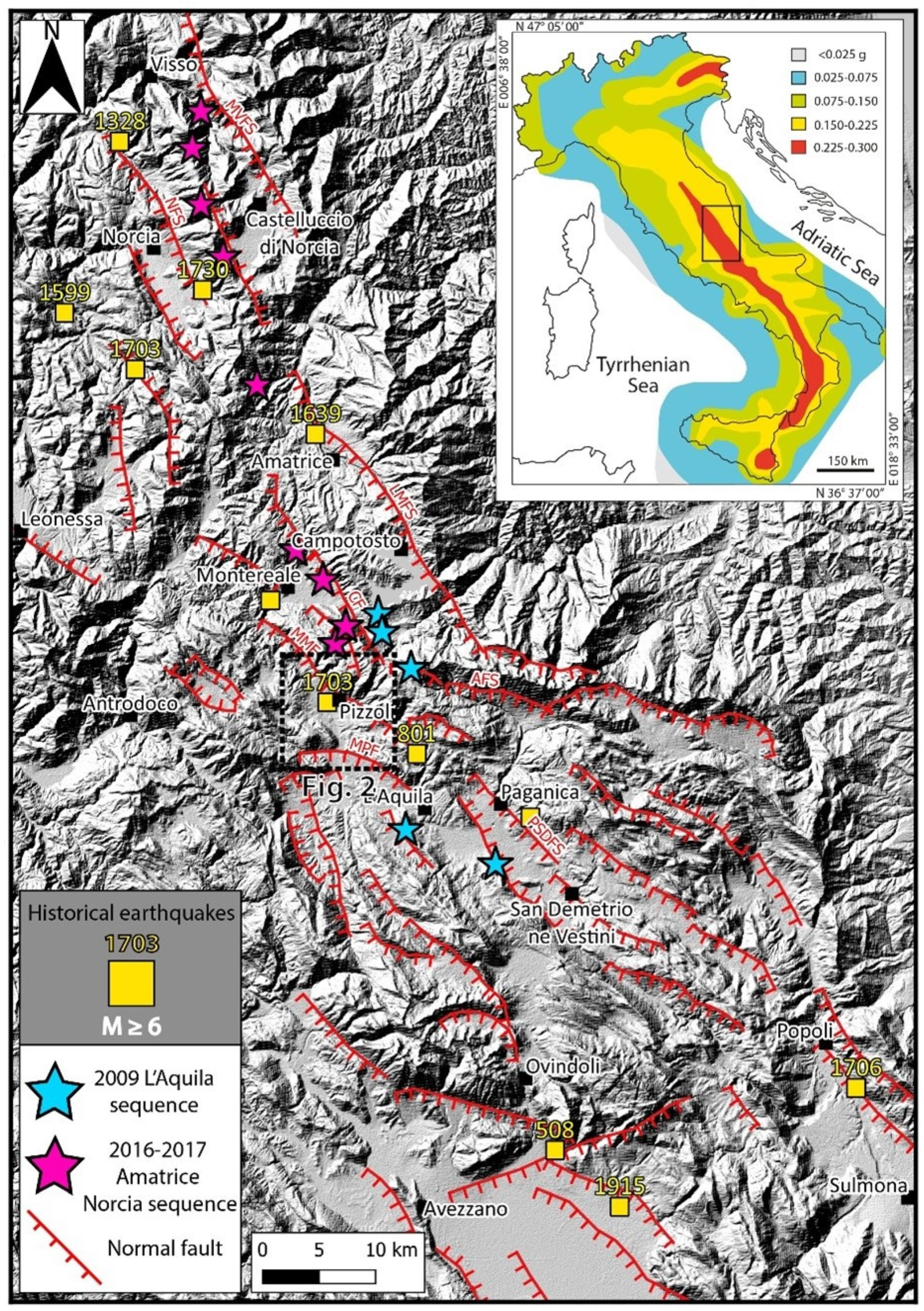


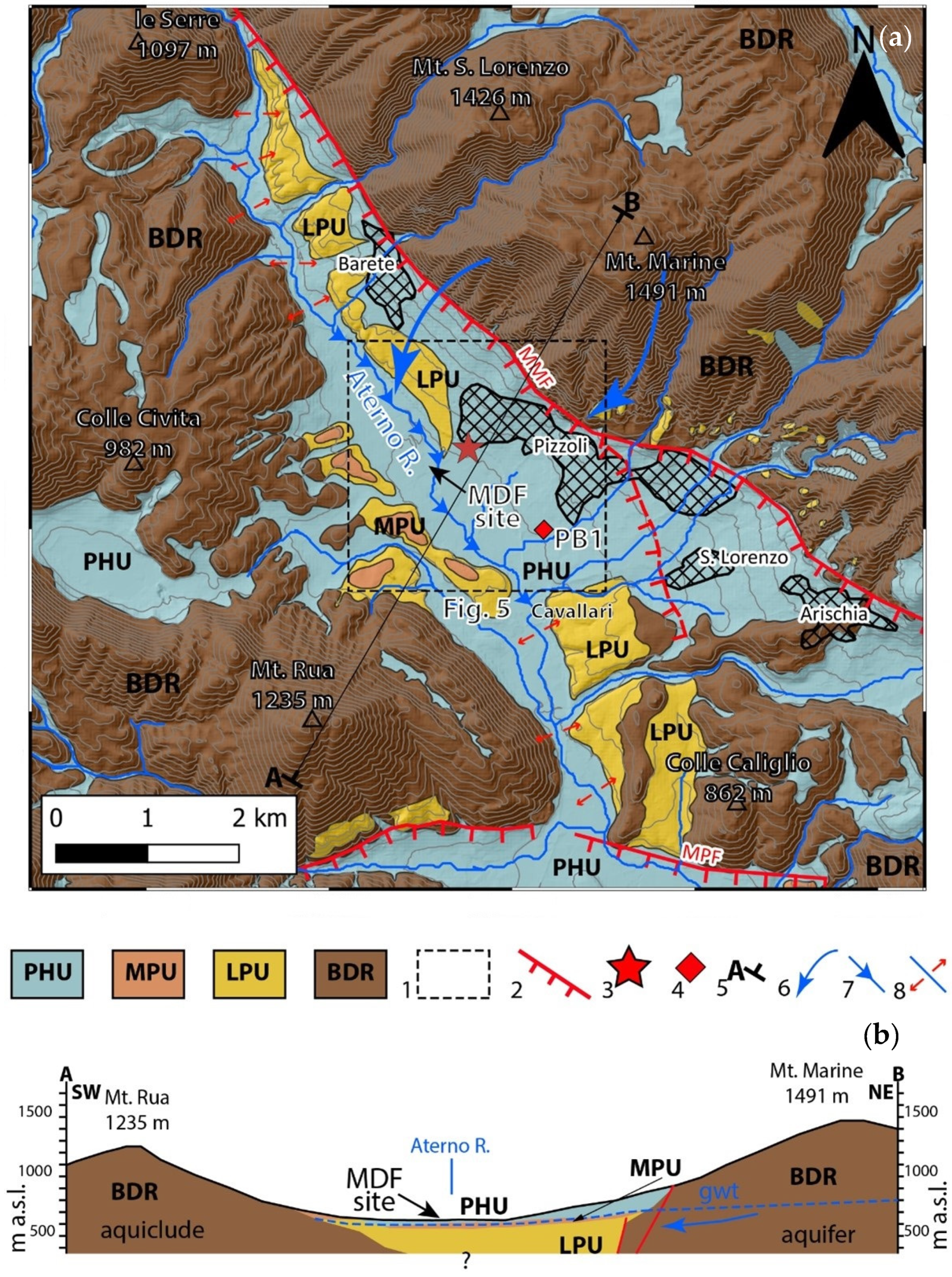
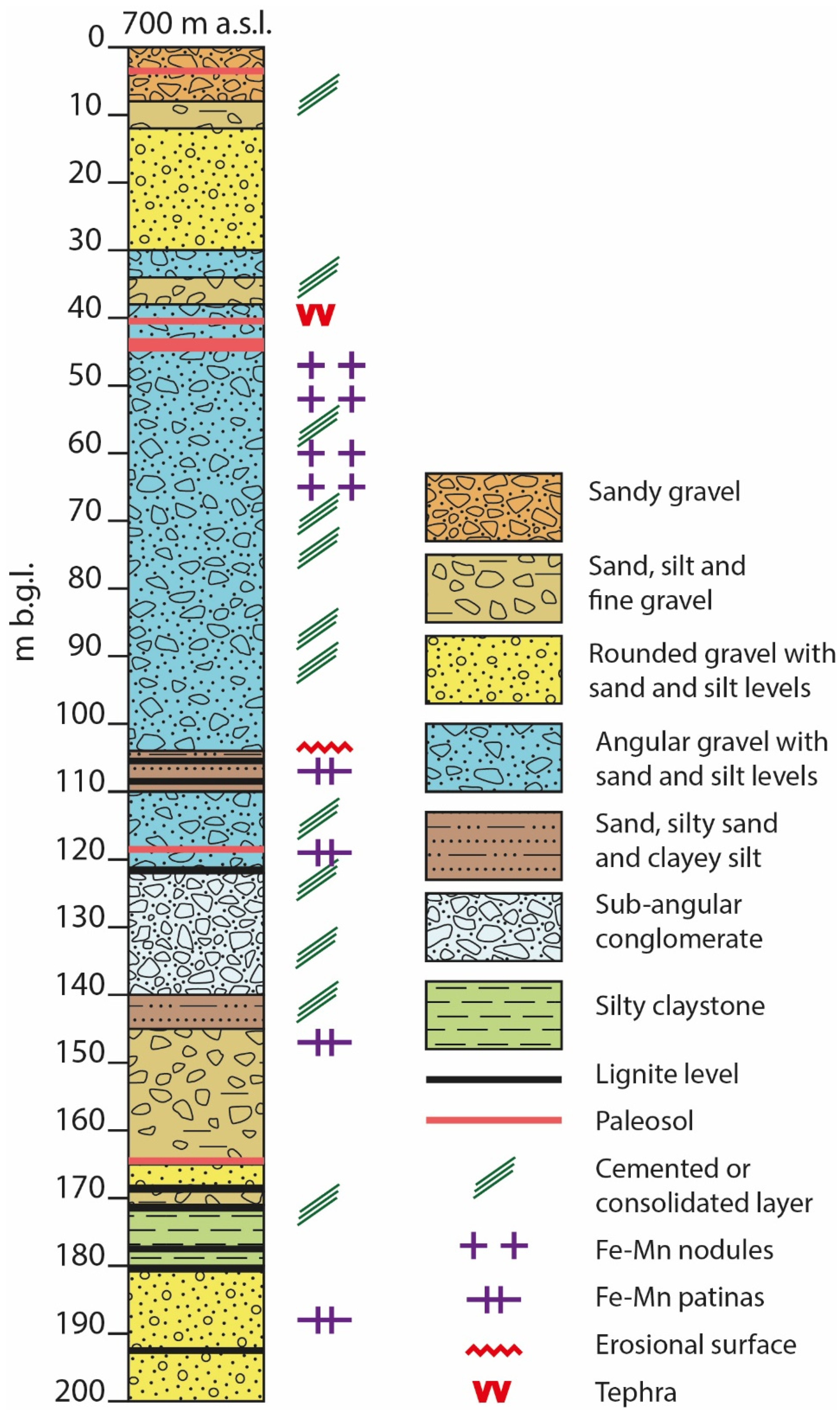
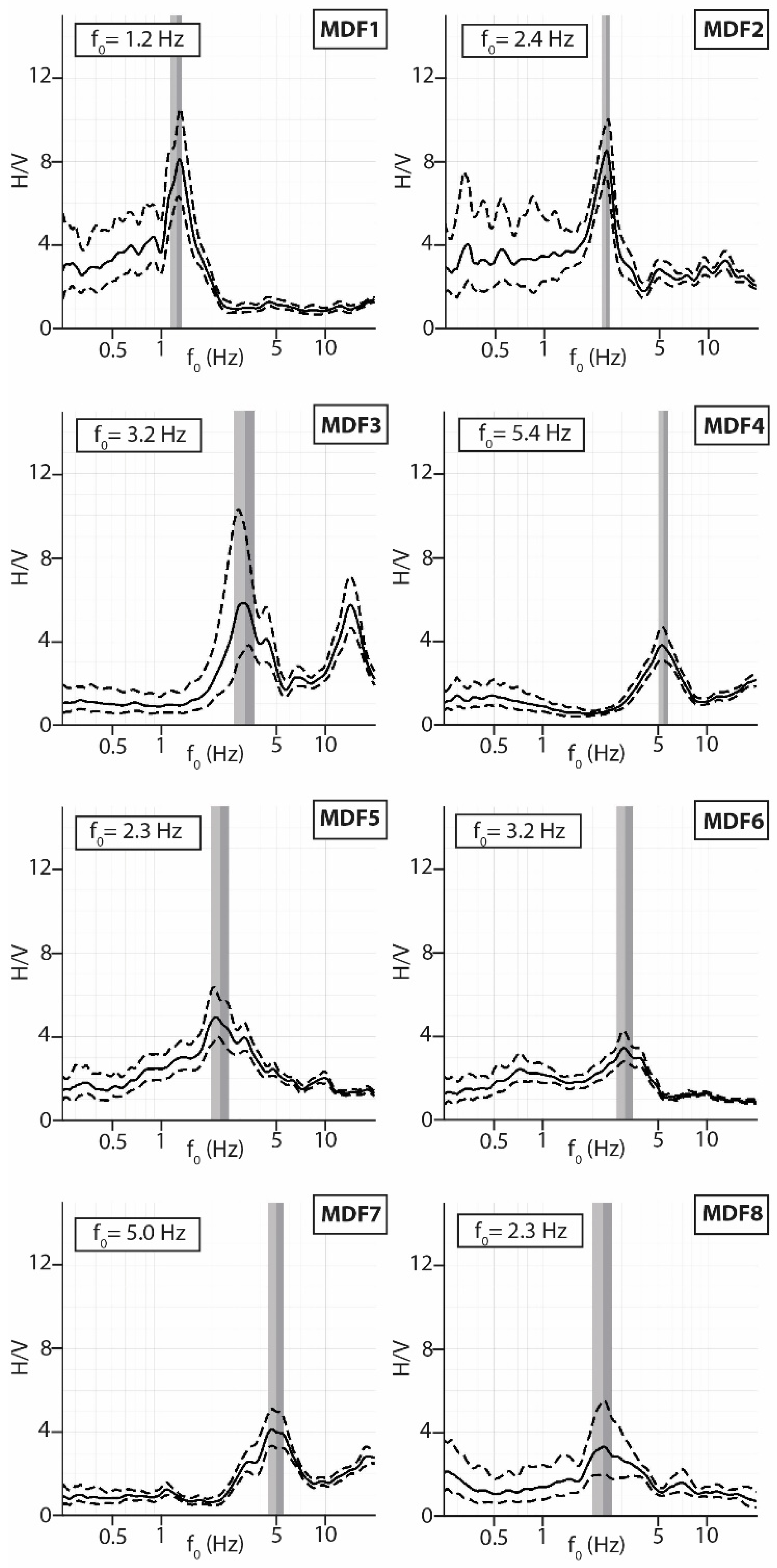
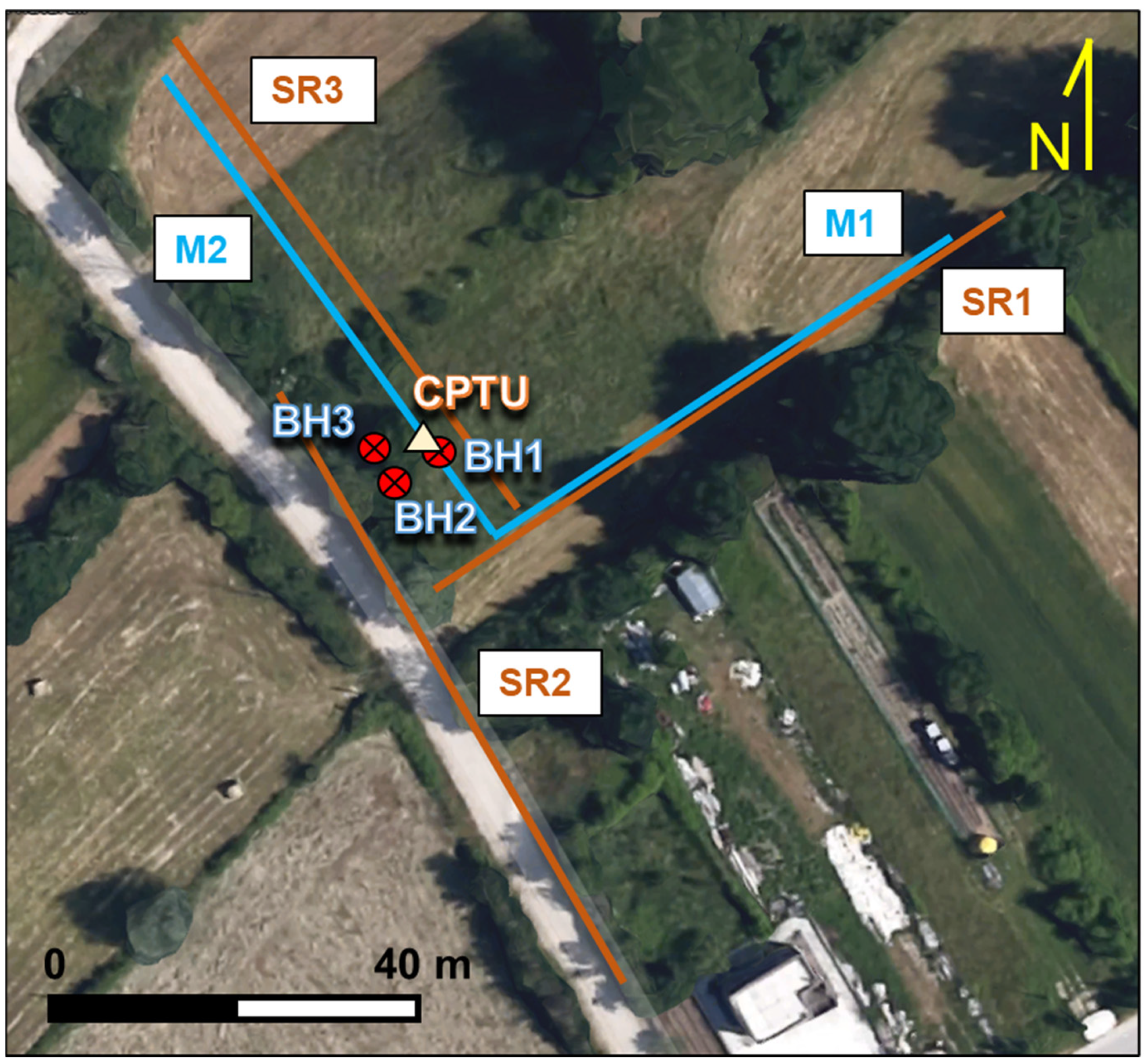

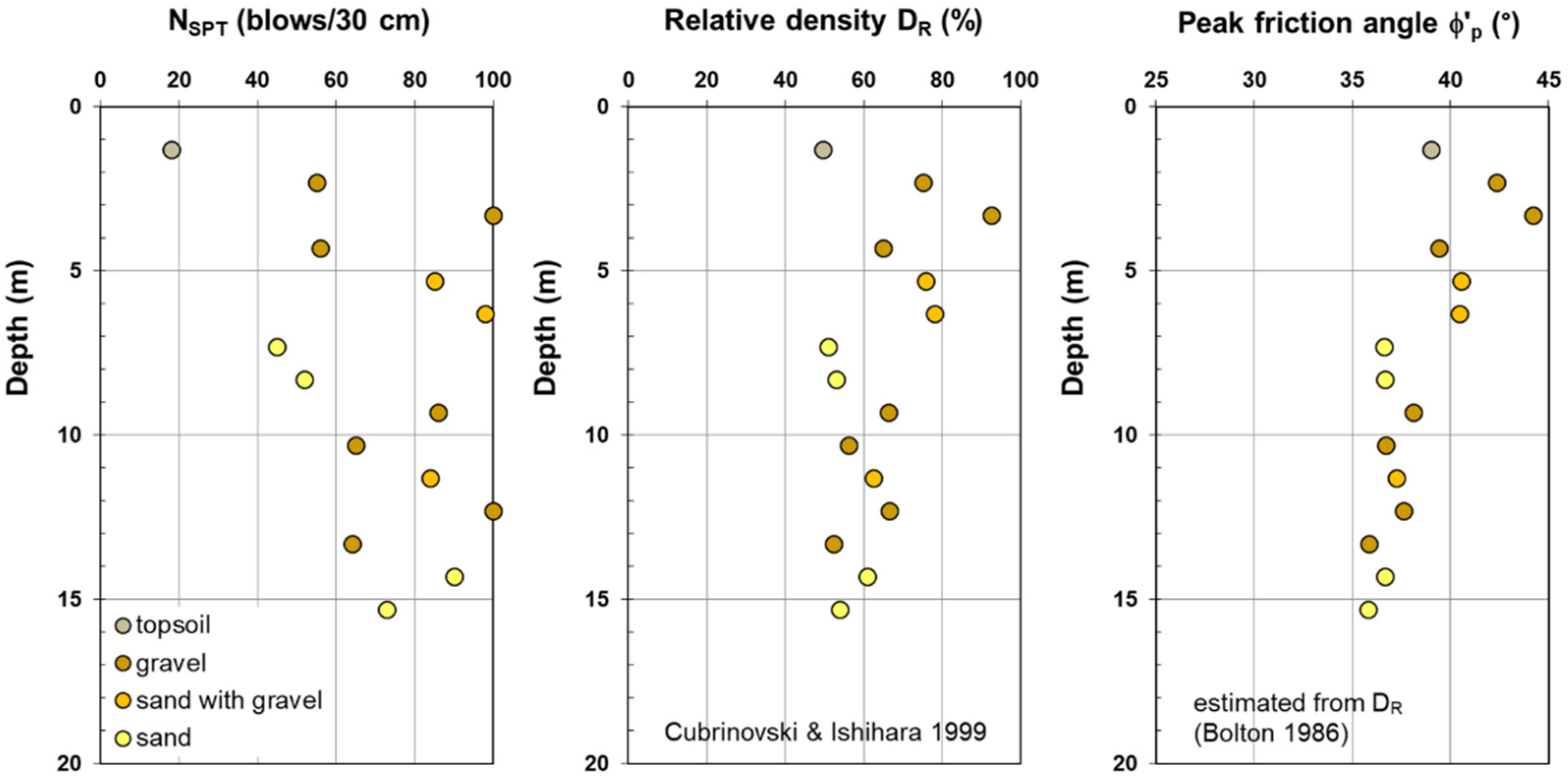

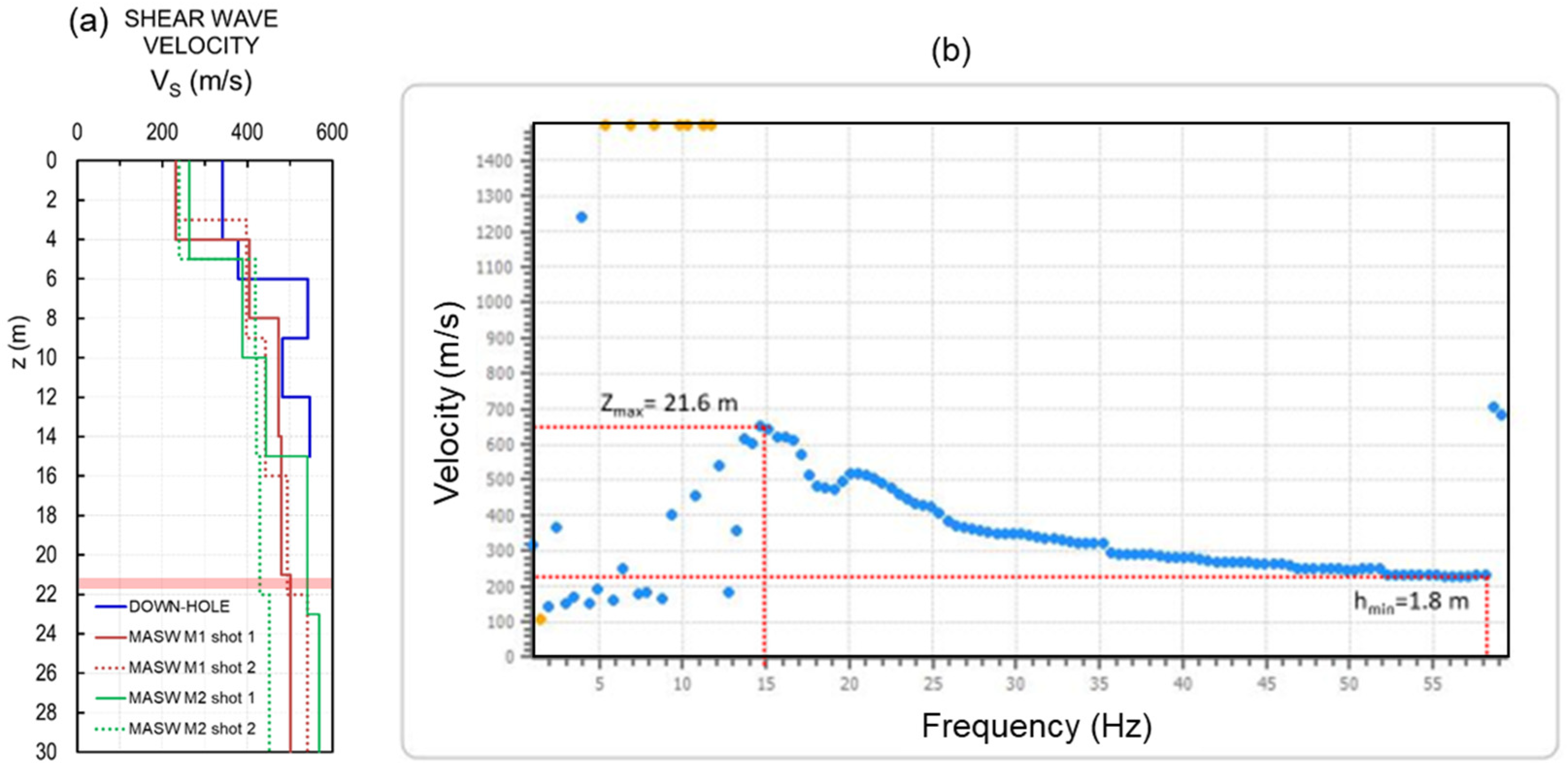

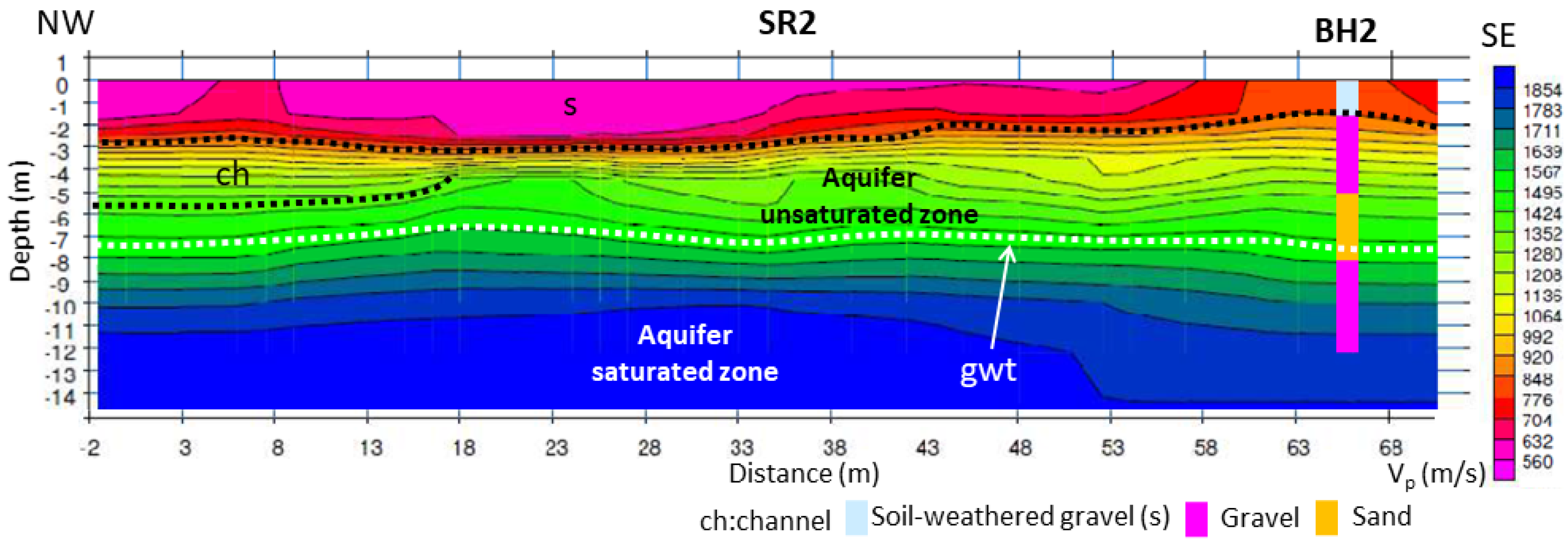

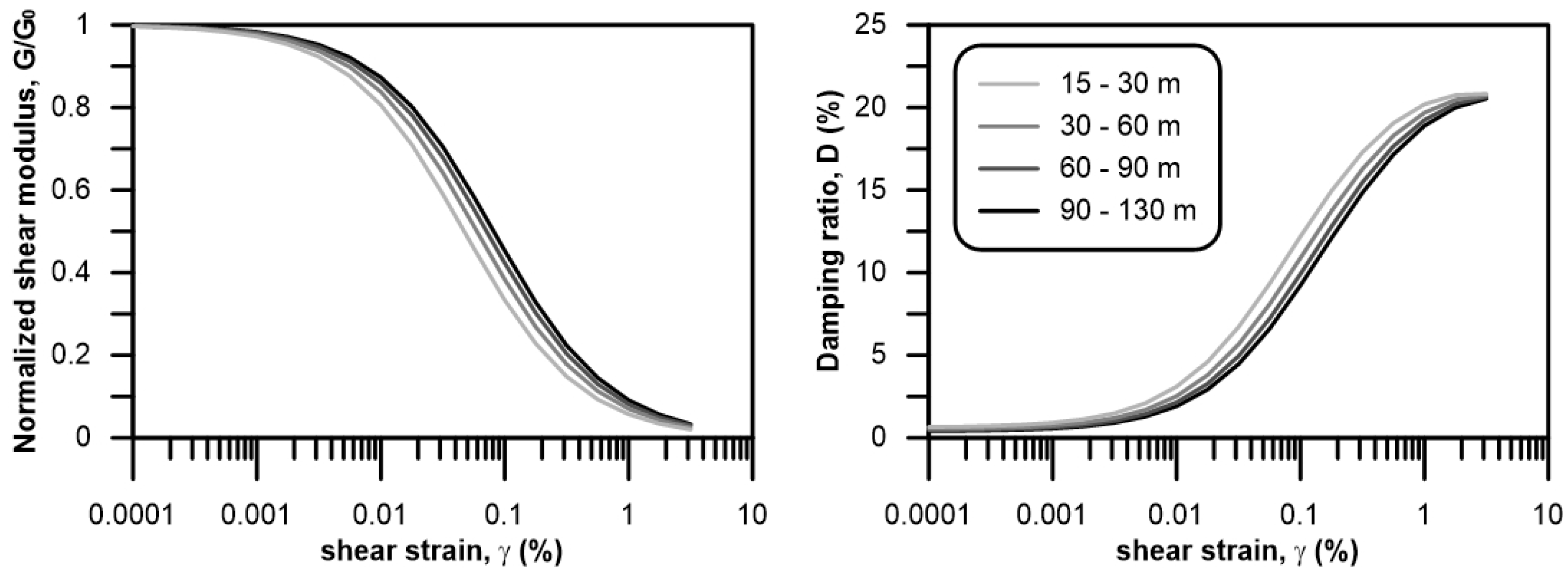
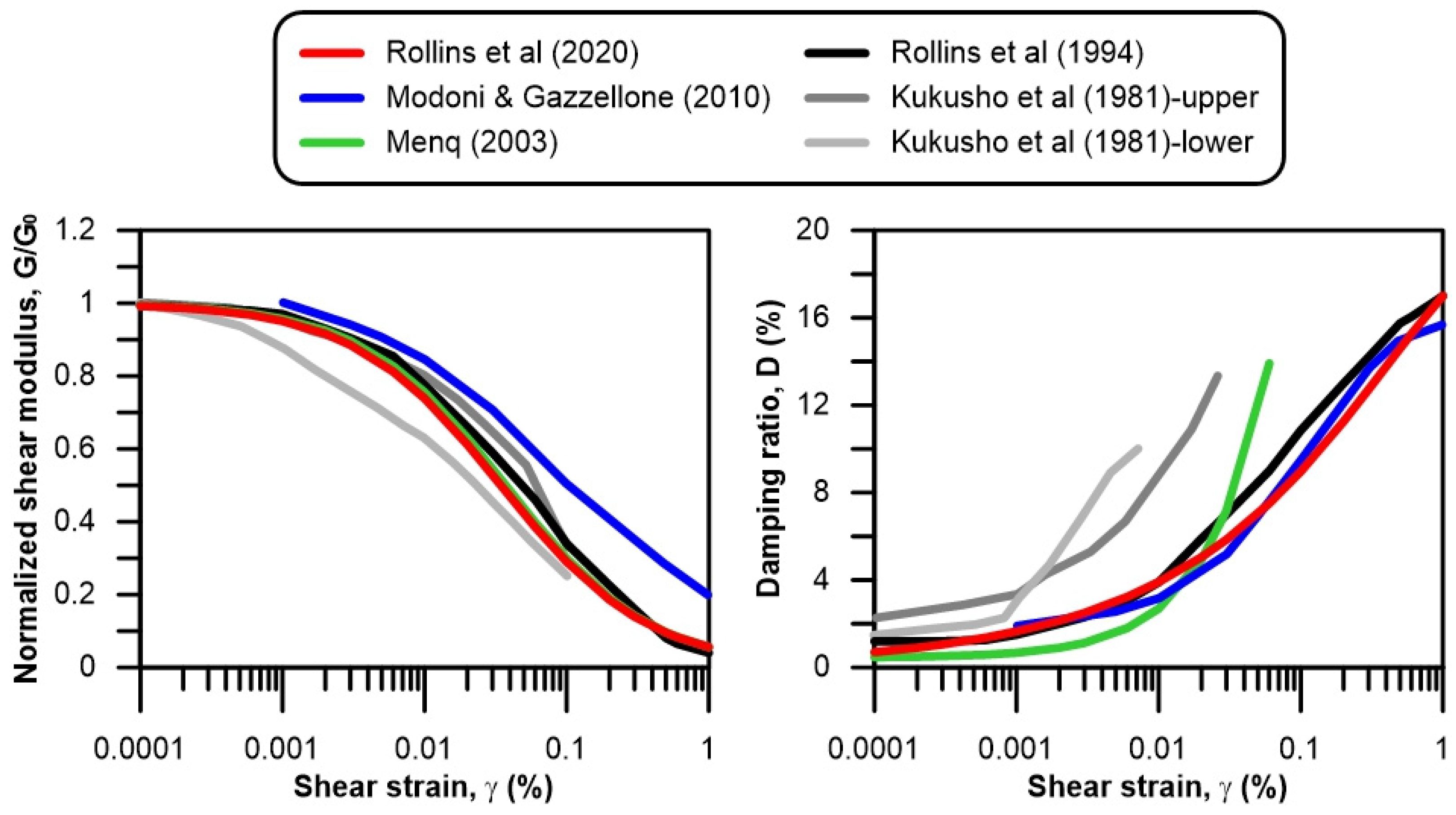

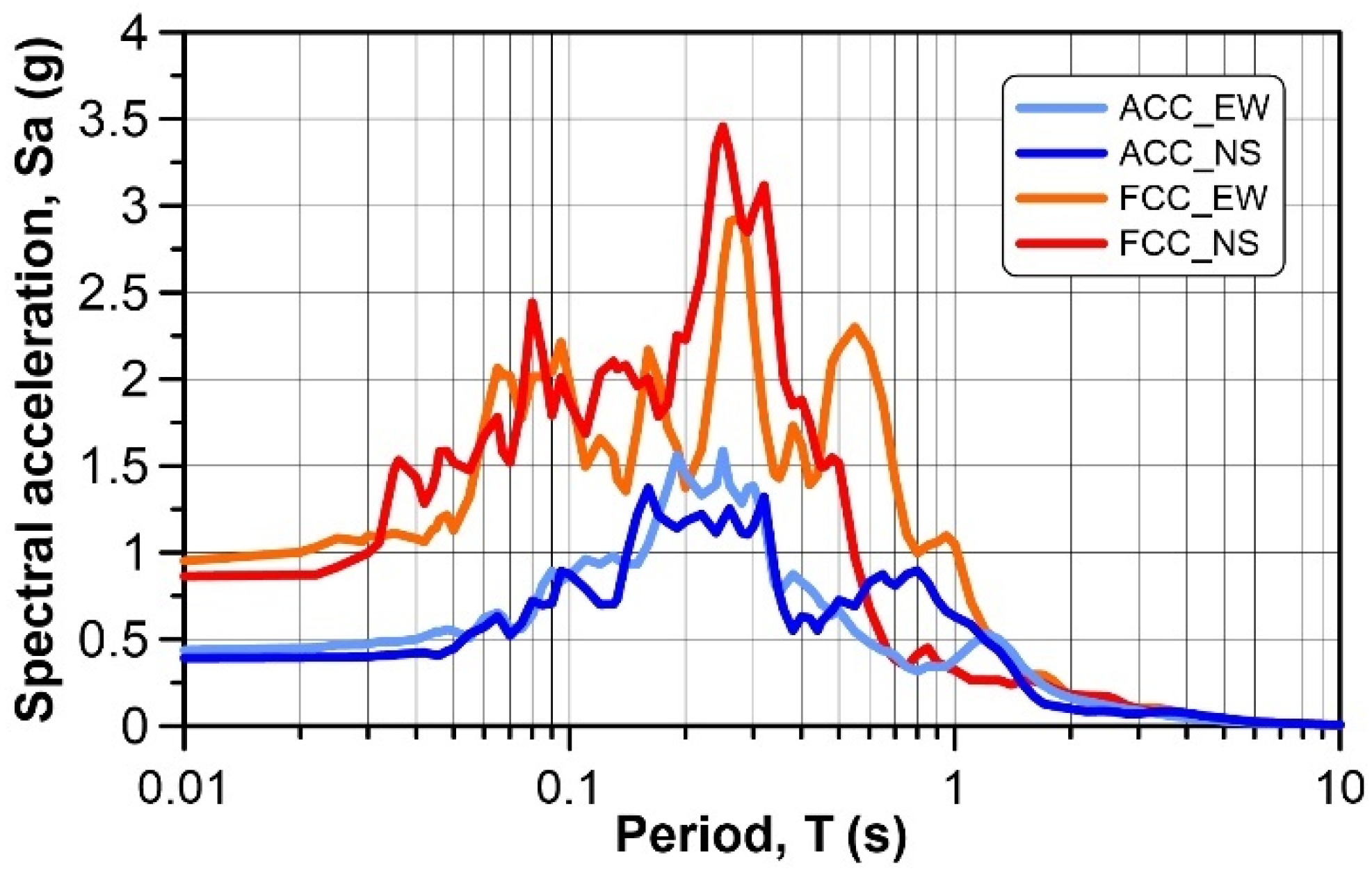
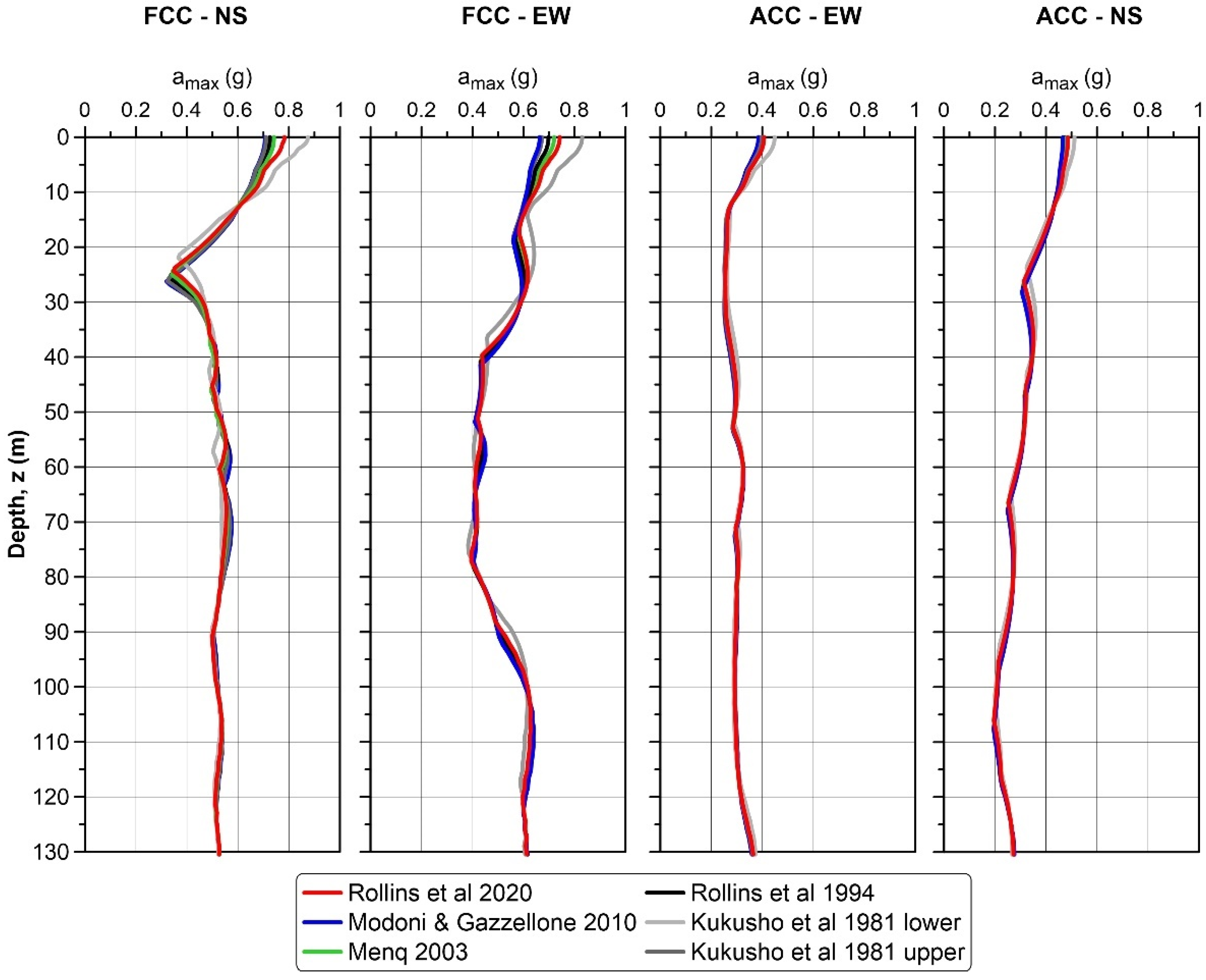
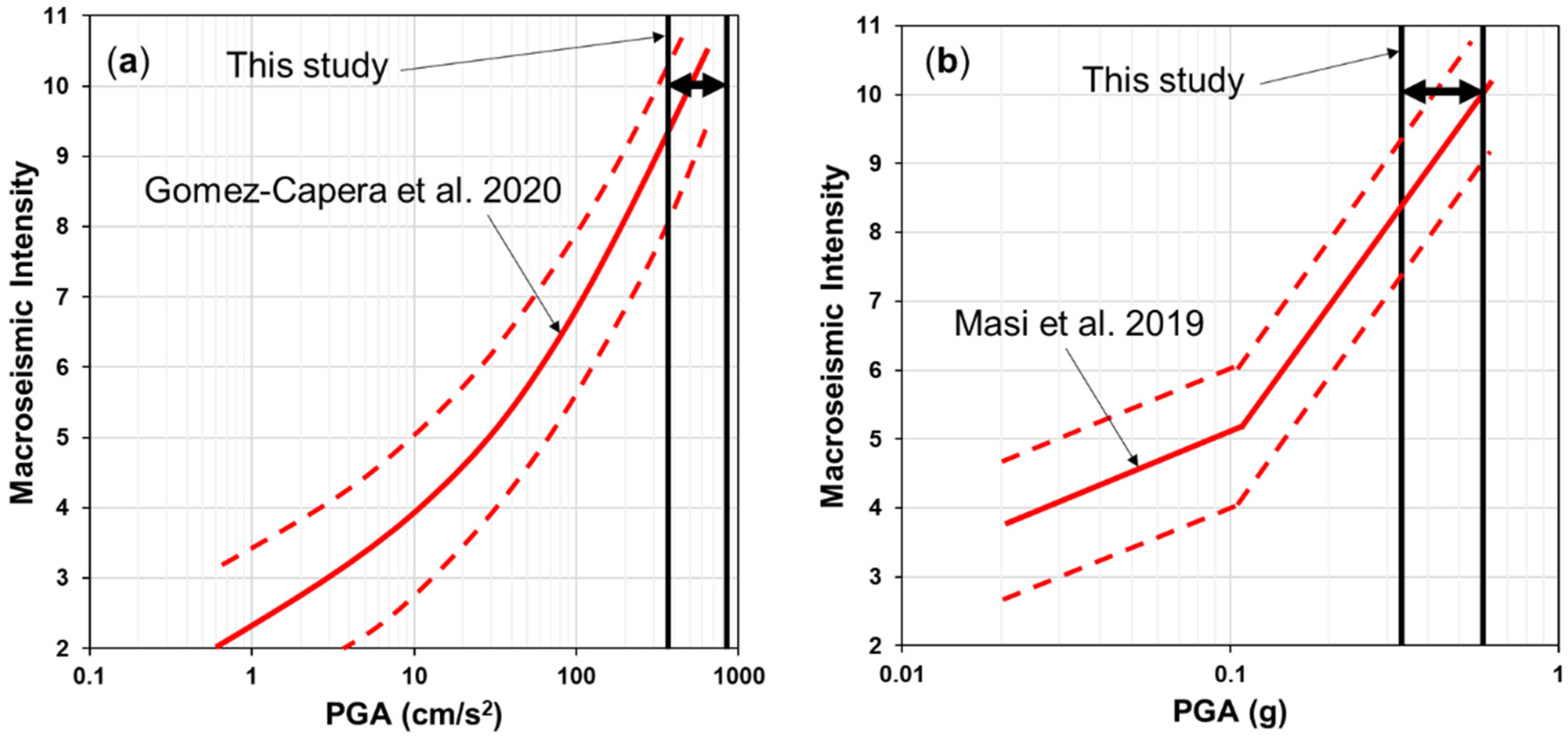

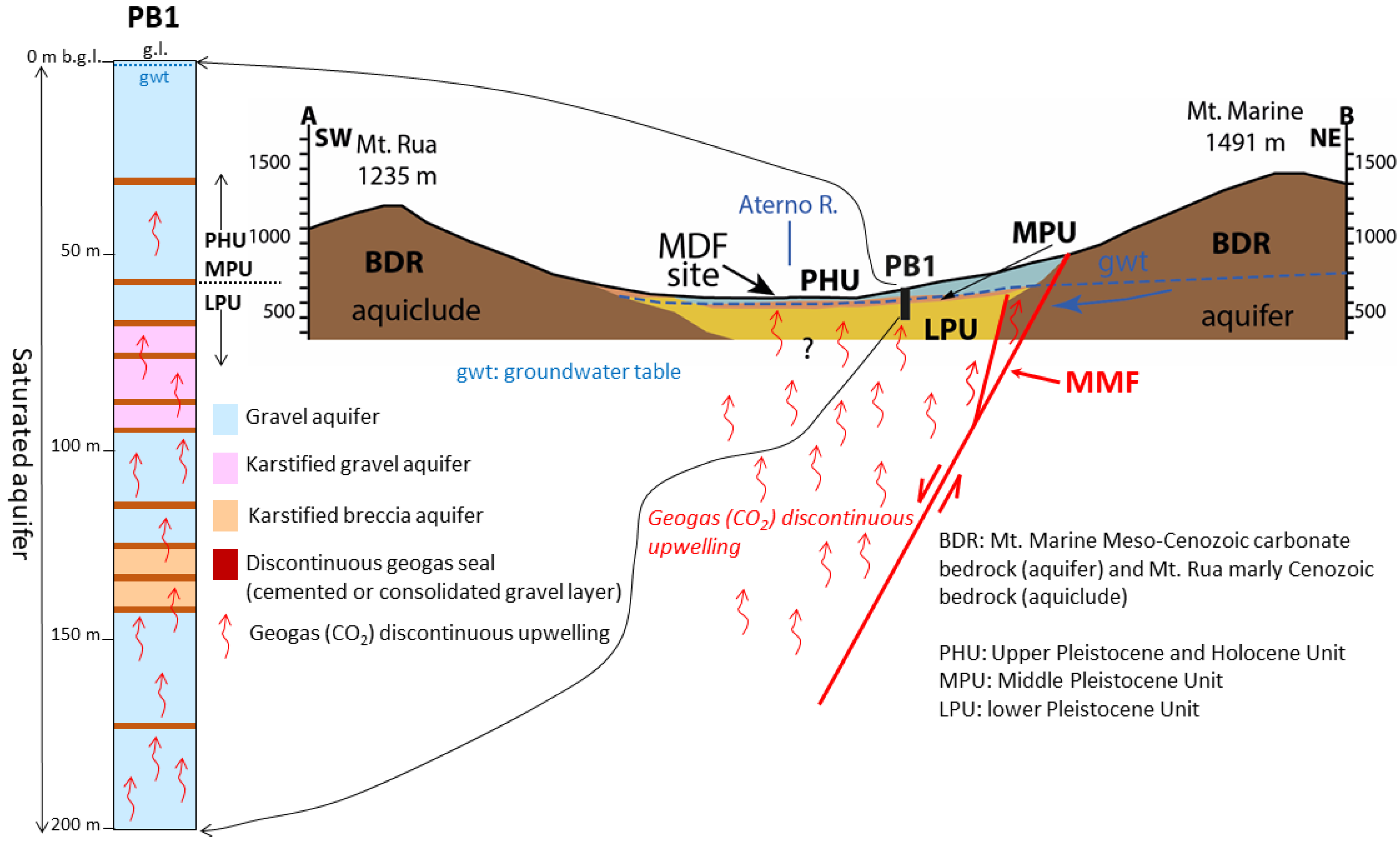
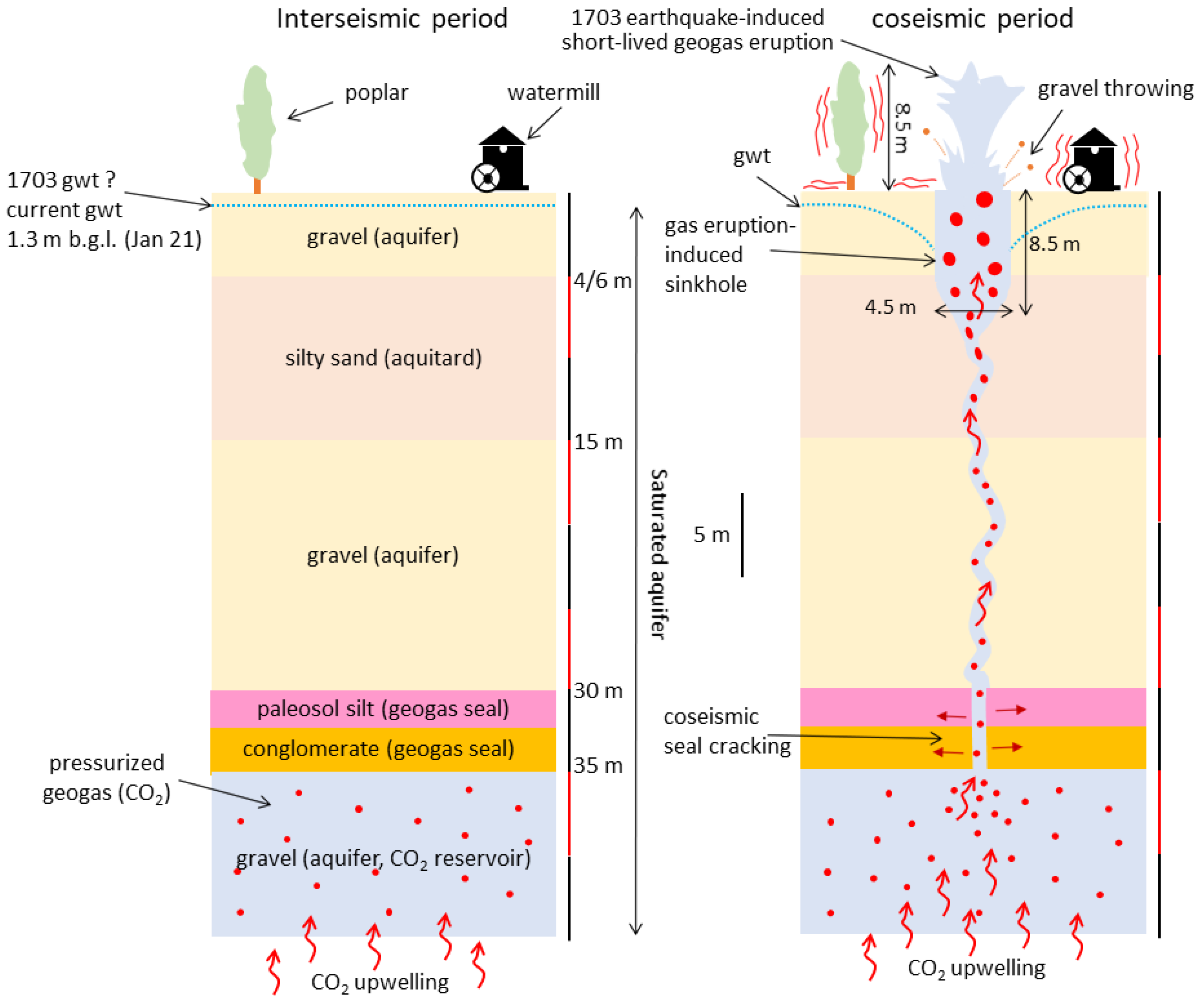
| Layout of the Survey | Technical Specifications |
|---|---|
| array: length and type | 69.0 m, linear array |
| geophone type | frequency: 4.5 Hz vertical component impedance: 430 Ώ |
| geophone: spacing and number | 3.0 m, 24 |
| energizing source type P waves | 10 kg sledge hammer, aluminum plate, 9 shots |
| seismograph | MAE mod. X820S, 24 channels at 16-24 bit per channel (https://www.mae-srl.it/it (6 December 2021) |
| sample interval | 0.0005 s |
| acquisition time window | 0.55 s |
| Layer | CSRt | α | CSRr | a | b | d |
|---|---|---|---|---|---|---|
| 0 ÷ 4 m | 0.001 | 8.49 | 13.74 | 0.784 | 0.349 | 9.327 |
| 4 ÷ 6 m | 0.001 | 31.92 | 66.33 | 0.775 | 0.28 | 7.913 |
| 6 ÷ 9 m | 0.001 | 4.03 | 3.78 | 0.784 | 0.393 | 10.21 |
| 9 ÷ 15 m | 0.001 | 16.26 | 23.81 | 0.781 | 0.315 | 8.638 |
| Event | ML | MW | Station Code | Repi (km) | PGA (g) | VS,30 1 (m/s) (Subsoil Class) | Topographic Class 1 |
| 30.X.2016 06:40:18 | 6.1 | 6.5 | CLO | 7.8 | 0.58 | 425 (B) | T1 |
| 30.X.2016 06:40:18 | 6.1 | 6.5 | T1212 | 10.5 | 0.28 | 537 (B) | T1 |
| 30.X.2016 06:40:18 | 6.1 | 6.5 | FCC | 11.0 | 0.95 | 917 (A) | T1 |
| 30.X.2016 06:40:18 | 6.1 | 6.5 | T1213 | 12.0 | 0.87 | 576 (B) | T1 |
| 30.X.2016 06:40:18 | 6.1 | 6.5 | ACC | 18.6 | 0.43 | 828 (A) | T1 |
| 30.X.2016 06:40:18 | 6.1 | 6.5 | MMO | 19.2 | 0.19 | 787 (B) | T1 |
| 24.VIII.2016 01:36:32 | 6.0 | 6.5 | MTR | 19.4 | 0.08 | 767 (B) | T1 |
Publisher’s Note: MDPI stays neutral with regard to jurisdictional claims in published maps and institutional affiliations. |
© 2021 by the authors. Licensee MDPI, Basel, Switzerland. This article is an open access article distributed under the terms and conditions of the Creative Commons Attribution (CC BY) license (https://creativecommons.org/licenses/by/4.0/).
Share and Cite
Chiaradonna, A.; Spadi, M.; Monaco, P.; Papasodaro, F.; Tallini, M. Seismic Soil Characterization to Estimate Site Effects Induced by Near-Fault Earthquakes: The Case Study of Pizzoli (Central Italy) during the Mw 6.7 2 February 1703, Earthquake. Geosciences 2022, 12, 2. https://doi.org/10.3390/geosciences12010002
Chiaradonna A, Spadi M, Monaco P, Papasodaro F, Tallini M. Seismic Soil Characterization to Estimate Site Effects Induced by Near-Fault Earthquakes: The Case Study of Pizzoli (Central Italy) during the Mw 6.7 2 February 1703, Earthquake. Geosciences. 2022; 12(1):2. https://doi.org/10.3390/geosciences12010002
Chicago/Turabian StyleChiaradonna, Anna, Marco Spadi, Paola Monaco, Felicia Papasodaro, and Marco Tallini. 2022. "Seismic Soil Characterization to Estimate Site Effects Induced by Near-Fault Earthquakes: The Case Study of Pizzoli (Central Italy) during the Mw 6.7 2 February 1703, Earthquake" Geosciences 12, no. 1: 2. https://doi.org/10.3390/geosciences12010002
APA StyleChiaradonna, A., Spadi, M., Monaco, P., Papasodaro, F., & Tallini, M. (2022). Seismic Soil Characterization to Estimate Site Effects Induced by Near-Fault Earthquakes: The Case Study of Pizzoli (Central Italy) during the Mw 6.7 2 February 1703, Earthquake. Geosciences, 12(1), 2. https://doi.org/10.3390/geosciences12010002









